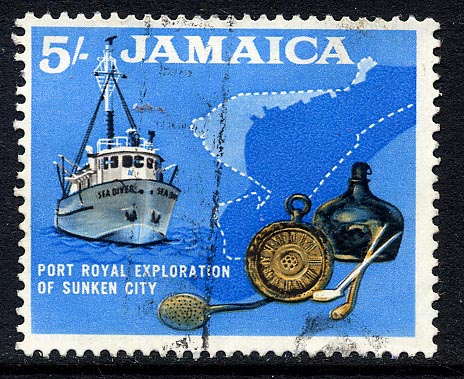
Jamaica's 5s, stamp has an inscription. It reads: "Port Royal, Exploration of Sunken City." The stamp depicts the yacht Sea Diver, which was used by the underwater explorers, a map of Port Royal, with the submerged part of the old city shown in white and a number of the objects brought to the surface by the expedition. These include a brass pocket watch made in Holland before 1686, churchwarden pipes, a brass skimmer, and a 17th century onion-shaped wine bottle.
The exploration of Port Royal took place during 10 weeks commencing in June 1959, under the auspices of the American National Geographic Society, the Smithsonian Institution, the Institute of Jamaica, and Mr. Edwin A. Link, famous American undersea explorer and archaeologist, and just as well-known as the inventor of the Link Trainer for air pilots. A six-man team of divers was lent by the U.S. Navy for the Port Royal expedition. On June 7, 1692, the notorious buccaneer capital of Jamaica was hit by an earthquake, and within two minutes two-thirds of Port Royal were submerged by the sea, 2,000 people perishing in the disaster. The 1959 expedition was the first serious attempt at locating the sunken city and bringing up any relics of historical interest and value.
The Sea Diver, was specially designed by Mr. Link himself for underwater research and exploration and was built at Quincy, Mass., in 1959, for the Sea Diver Corporation of New York, Mr. Link s company. Completed in 1959, the motor yacht is the second craft of this name owned by Mr. Link, the original Sea Diver being a converted shrimp boat which had made a preliminary visit to Port Royal in 1956. The modern vessel has a gross tonnage of 158, 108 net, a length of 84 ft. 3 in., beam of 22 ft. 6 in. and depth of 9 ft. 7 in. Two years in the building, the Sea Diver is a steel vessel powered by twin oil engines, and has accommodation for 12 persons. Electrical power is supplied by two generators. A large electrically-driven compressor provides air for the divers and operates a 10-in, diameter suction pipe, which can also be used as a hose for sweeping away silt from underwater objects. One of the many unusual fittings is the Sea Diver's special diving compartment at the stern which can be entered both from the vessel's deck and directly from the sea. The compartment acts as the Store for all the diving equipment.
Heavy booms and electric winches of unusual strength and power for a craft of this size are provided on deck for heavy lifts. The ocean bed can be examined through the specially built-in thick glass plates deep in the ship's bows, while the wheelhouse includes, besides the usual navigating aids, a brace of echo-sounding devices for reading the depth. The Sea Diver can also be partly jet-propelled by means of two nozzles placed under her bows on each side of the keel. By ejection of water from one side or the other at high velocity the vessel can turn in her own length, and she can move sideways by using her stern screws and bow jets.On the afterdeck the vessel carries an 18 ft. launch, the Reef Diver, which is wholly propelled by water jet, so that she can work over reefs and in other shallow places, without the risk to divers of a turning propeller.
Undersea operations of an earlier day are depicted on the current 5s. stamp of the Bahamas. This stamp depicts the strange 1914 Williamson Film Project in which the first films ever taken beneath the waves were successfully made. This is the second appearance of the Photosphere on stamps, it having previously been shown on the 25 cents stamp of Monaco's Underwater Exploration series of 1962.
SG230 Sea Breezes 7/65
